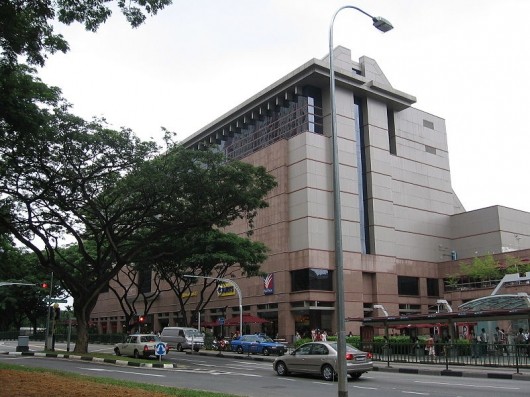Eye on Tiong Bahru: Convenience in Proximity

Tiong Bahru Plaza houses 165 shops and three floors of basement car park.
Rich with architectural, cultural and historic significance, the mention of Tiong Bahru often evokes a sense of nostalgia.
However, the area, particularly Tiong Bahru estate, has seen a rejuvenation in recent years with many new and trendy commercial tenants.
Tiong Bahru estate was developed in the 1920s as Singapore’s first public housing estate, by the Singapore Improvement Trust (SIT), the Housing and Development Board (HDB)’s predecessor.
After World War II, more flats were added to the estate. The SIT flats were inspired by public housing in British new towns then such as Stevenage and Harlow, but they also incorporated local styles. The flats were designed based on a typical shophouse with added improvements, featuring rounded balconies, exterior spiral staircases, courtyards, and air-wells. It is also easy to spot elements of Art Deco and the influence of the International style, which was prominent in Europe during that period, in the architecture.
The layout of the estate also incorporated open spaces and a communal zone that included a market and hawker centre and coffee shops.
In 2003, 20 blocks of two- to five-storey flats in the estate were granted conservation status by the Urban Redevelopment Authority (URA).
There were also other signs of renewal in other parts of the area. In 2011, Blocks 9A, 9B, 10A and 10B bounded by Tiong Bahru Road and Jalan Bukit Ho Swee underwent the Selective En bloc Redevelopment Scheme, (SERS) programme. Named Tiong Bahru View, the new HDB development comprises three 40-storey and one 25 or 30-storey residential blocks, offering a total of 700 units of Studio Apartments, three-room, four-room and five-room flats.
Due to its location, Tiong Bahru is one of the few city fringe areas that is well connected to the CBD area. The Tiong Bahru MRT station runs the East-West line and it takes residents about ten minutes to get to the financial district. The upcoming Havelock MRT station will also make a convenient commute along the Thomson line. Tiong Bahru is also well connected via major expressways such at the Central Expressway (CTE) and Ayer Rajah Expressway (AYE).
Nicholas Mak Executive Director at SLP International observed Tiong Bahru has locality in its favour resulting in an active rental market for residential as well as industrial tenants. A plus point is that there is not a lot of new supply to compete with, unless there are new residential developments, making it a popular area with buyers and investors.
He added that vacant land for new HDB flats are quite limited, although there may be room for private developments in future.
Currently, all condominiums there saw a price increase last year. “Condo prices in Tiong Bahru have risen from one percent to 16 percent year-on-year from 2012 to 2013. For example, a freehold condo was transacted at $1,660 to $1,760 psf while another 99-year leasehold development was sold at $1,350 to $1,470 psf. We can see that the market and prices there are quite robust,” Mak said.
He foresees that prices are likely to hold steady this year but it also depends on the new condominiums coming up within the vicinity, as their launching price will likely affect the resale market around the area.
However, Mak noted that if the population in Tiong Barhu was to increase, it would be hard to build a second shopping mall to meet the needs of the residents unless something is demolished to make way. The current mall is the medium-sized Tiong Bahru Plaza near the Tiong Barhu MRT to serve the population in the HDB estates and condominium developments in the area.
One of the private projects in the pipeline is the Highline Residences. In April 2013, Keppel Land, through its wholly-owned subsidiary, Harvestland Development Pte Ltd, won the bid for the residential site at Kim Tian Road for $550.28 million. The development will have green features including an urban farm on top of a tower block and a 180-metre elevated green ridge stretching across several blocks, drawing comparison with High Line Linear Park in New York.
Residents at Tiong Bahru have plenty of recreational choices and green spaces for a respite from urban living. The Master Plan 2014 by the URA revealed that a new park was planned at Kim Tian Road, in addition to the existing Tiong Bahru Park.
Named an Arts and Heritage Park by National Park Boards (NParks), Tiong Bahru Park was first developed around 1967 for residents in Henderson, Bukit Merah and Lower Delta Road. The park was later redeveloped in 2000 with a theme of “Old Frame, New Images”. The upgraded park now has a livelier setting and features many new facilities to meet the recreational needs of different groups of residents. For instance, the iconic tilting train with various slides in the adventure playground a favourite among children.
Other facilities include a pond pavilion, foot reflexology footpath and fitness stations with exercise equipment, providing opportunities for social interaction and family activities.
Families with children have a choice of a range of schools within the area including Zhangde Primary School and Gan Eng Seng Secondary School.
While it is often said that Singapore has changed quickly in short period of time, places like Tiong Bahru which holds on to the charm and beauty of yesteryears reminds us of how far the country has come.
Article by:
Muneerah Bee
